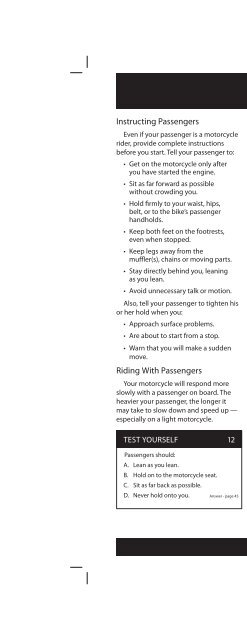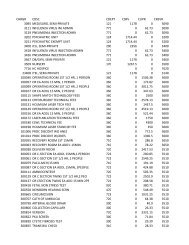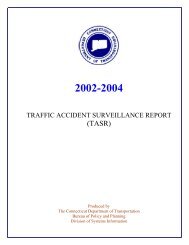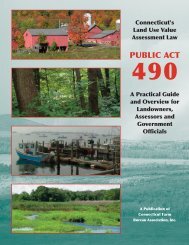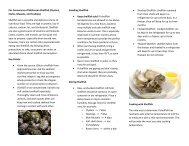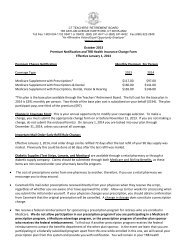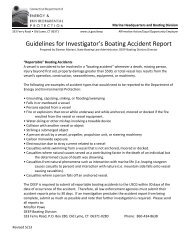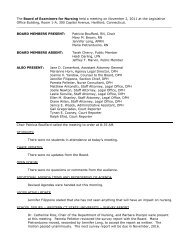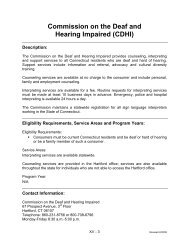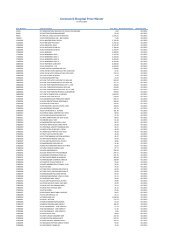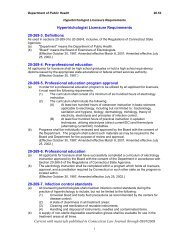The Connecticut Motorcycle Operator's Manual - CT.gov
The Connecticut Motorcycle Operator's Manual - CT.gov
The Connecticut Motorcycle Operator's Manual - CT.gov
You also want an ePaper? Increase the reach of your titles
YUMPU automatically turns print PDFs into web optimized ePapers that Google loves.
Instructing Passengers<br />
Even if your passenger is a motorcycle<br />
rider, provide complete instructions<br />
before you start. Tell your passenger to:<br />
• Get on the motorcycle only after<br />
you have started the engine.<br />
• Sit as far forward as possible<br />
without crowding you.<br />
• Hold fi rmly to your waist, hips,<br />
belt, or to the bike’s passenger<br />
handholds.<br />
• Keep both feet on the footrests,<br />
even when stopped.<br />
• Keep legs away from the<br />
muffl er(s), chains or moving parts.<br />
• Stay directly behind you, leaning<br />
as you lean.<br />
• Avoid unnecessary talk or motion.<br />
Also, tell your passenger to tighten his<br />
or her hold when you:<br />
• Approach surface problems.<br />
• Are about to start from a stop.<br />
• Warn that you will make a sudden<br />
move.<br />
Riding With Passengers<br />
Your motorcycle will respond more<br />
slowly with a passenger on board. <strong>The</strong><br />
heavier your passenger, the longer it<br />
may take to slow down and speed up —<br />
especially on a light motorcycle.<br />
TEST YOURSELF 12<br />
Passengers should:<br />
A. Lean as you lean.<br />
B. Hold on to the motorcycle seat.<br />
C. Sit as far back as possible.<br />
D. Never hold onto you.<br />
Answer - page 45<br />
37<br />
• Ride a little slower, especially<br />
when taking curves, corners or<br />
bumps.<br />
• Start slowing earlier as you<br />
approach a stop.<br />
• Open up a larger cushion of<br />
space ahead and to the sides.<br />
• Wait for larger gaps to cross,<br />
enter or merge in traffi c.<br />
Warn your passenger of special<br />
conditions — when you will pull out,<br />
stop quickly, turn sharply or ride over a<br />
bump. Turn your head slightly to make<br />
yourself understood, but keep your eyes<br />
on the road ahead.<br />
Carrying Loads<br />
Most motorcycles are not designed<br />
to carry much cargo. Small loads can be<br />
carried safely if positioned and fastened<br />
properly.<br />
• Keep the Load Low — Fasten<br />
loads securely, or put them in<br />
saddlebags. Piling loads against a<br />
sissybar or frame on the back of the<br />
seat raises the motorcycle’s center<br />
of gravity and disturbs its balance.<br />
• Keep the Load Forward — Place<br />
the load over, or in front of, the rear<br />
axle. Tankbags keep loads forward,<br />
but use caution when loading hard<br />
or sharp objects. Make sure the<br />
tankbag does not interfere with<br />
handlebars or controls. Mounting<br />
loads behind the rear axle can aff ect<br />
how the motorcycle turns and<br />
brakes. It can also cause a wobble.<br />
• Distribute the Load Evenly —<br />
Load saddlebags with about the<br />
same weight. An uneven load can<br />
cause the motorcycle to drift to one<br />
side.


